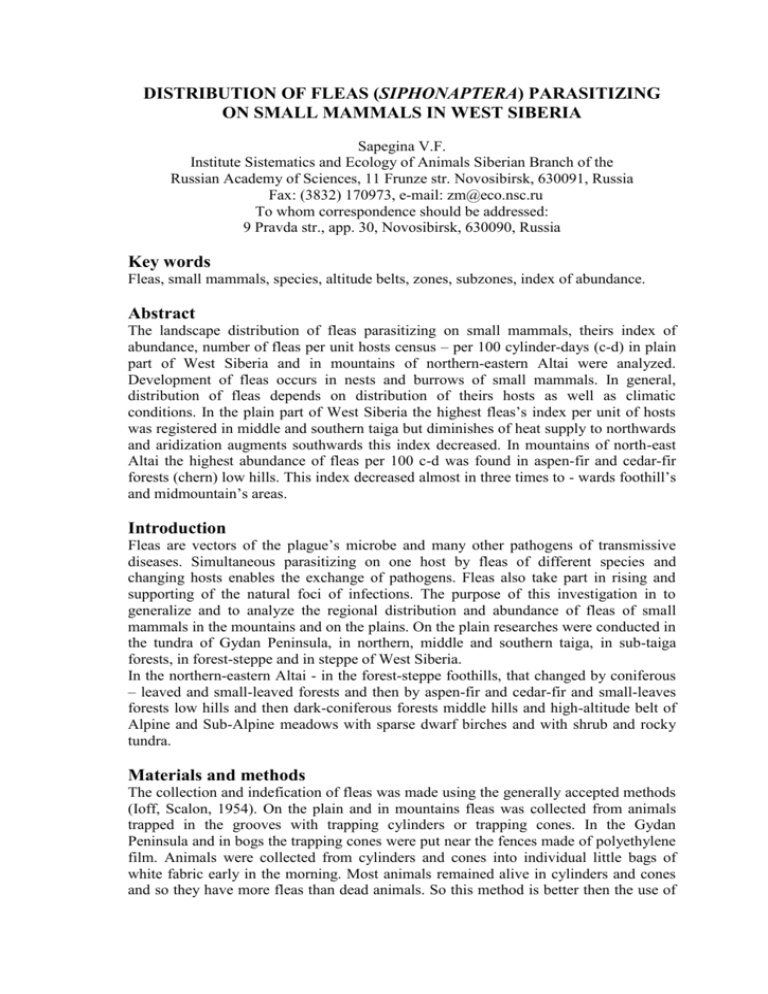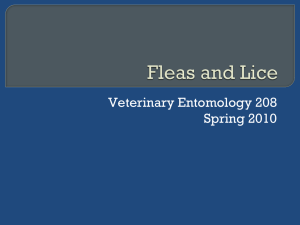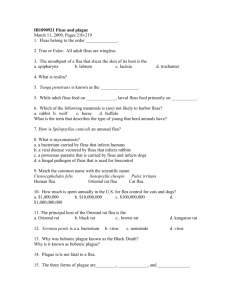DISTRIBUTION OF FLEAS (SIPHONAPTERA) PARASITIZING ON
advertisement

DISTRIBUTION OF FLEAS (SIPHONAPTERA) PARASITIZING ON SMALL MAMMALS IN WEST SIBERIA Sapegina V.F. Institute Sistematics and Ecology of Animals Siberian Branch of the Russian Academy of Sciences, 11 Frunze str. Novosibirsk, 630091, Russia Fax: (3832) 170973, e-mail: zm@eco.nsc.ru To whom correspondence should be addressed: 9 Pravda str., app. 30, Novosibirsk, 630090, Russia Key words Fleas, small mammals, species, altitude belts, zones, subzones, index of abundance. Abstract The landscape distribution of fleas parasitizing on small mammals, theirs index of abundance, number of fleas per unit hosts census – per 100 cylinder-days (c-d) in plain part of West Siberia and in mountains of northern-eastern Altai were analyzed. Development of fleas occurs in nests and burrows of small mammals. In general, distribution of fleas depends on distribution of theirs hosts as well as climatic conditions. In the plain part of West Siberia the highest fleas’s index per unit of hosts was registered in middle and southern taiga but diminishes of heat supply to northwards and aridization augments southwards this index decreased. In mountains of north-east Altai the highest abundance of fleas per 100 c-d was found in aspen-fir and cedar-fir forests (chern) low hills. This index decreased almost in three times to - wards foothill’s and midmountain’s areas. Introduction Fleas are vectors of the plague’s microbe and many other pathogens of transmissive diseases. Simultaneous parasitizing on one host by fleas of different species and changing hosts enables the exchange of pathogens. Fleas also take part in rising and supporting of the natural foci of infections. The purpose of this investigation in to generalize and to analyze the regional distribution and abundance of fleas of small mammals in the mountains and on the plains. On the plain researches were conducted in the tundra of Gydan Peninsula, in northern, middle and southern taiga, in sub-taiga forests, in forest-steppe and in steppe of West Siberia. In the northern-eastern Altai - in the forest-steppe foothills, that changed by coniferous – leaved and small-leaved forests and then by aspen-fir and cedar-fir and small-leaves forests low hills and then dark-coniferous forests middle hills and high-altitude belt of Alpine and Sub-Alpine meadows with sparse dwarf birches and with shrub and rocky tundra. Materials and methods The collection and indefication of fleas was made using the generally accepted methods (Ioff, Scalon, 1954). On the plain and in mountains fleas was collected from animals trapped in the grooves with trapping cylinders or trapping cones. In the Gydan Peninsula and in bogs the trapping cones were put near the fences made of polyethylene film. Animals were collected from cylinders and cones into individual little bags of white fabric early in the morning. Most animals remained alive in cylinders and cones and so they have more fleas than dead animals. So this method is better then the use of mouse snap traps, in which animals usually die. So for the zoogeographical analysis of the fleas distribution we collected fleas from animals, trapped in the groves with trapping cylinders or cones. We used the index of abundance calculated as the number of fleas per one of animal and the number of fleas per unit host census-per 100 cylinderdays (c-d). 44 species of fleas were recorded on small mammals in West Siberia. Results In northern-eastern Altai on small mammals were recorded 29 of fleas species. The highest biodiversity of fleas species and number of fleas on 100 c-d were recorded in cherneviye low hills (table 1). Table 1 Distribution of the fleas on the small mammals in the different landscapes of northern-eastern Altai Altitude belts The forest-steppe altitude belt Coniferous-leaved and smallleaved forests of low hills Chern of low hills Small-leaved forests of low hills Dark-coniferous forests of middles hills Fir-cedar of sparse forests of middles hills Shrub and rocky tundra of high mountains 1315 Number of animals 100 c-d* 40 11 Index abundance of fleas 1.3 4128 86 15 0.7 60.2 4371 198 19 0.8 158.4 163 110 8 0.5 55.0 837 98 15 0.5 49.0 110 105 12 0.5 52.0 25 — 3 0.3 — Number of small animals Number of fleas species Fleas on 100 c-d 52.0 This index decreased towards foothills and midmountain areas. However the highest index of abundance of fleas on small mammals are found in forest-steppe, but higher in the mountains this value diminished. This can be explained by occurrence of the foreststeppe species Ctenophtalmus. assimilis Tasch. which is dominant. Six species of fleas were dominant in northern-eastern Altai. The following species were dominant in particular altitude belts: Ct. Assimilis in the forest-steppe altitude belt, Rhadinopsylla altaica Wagn. in fir-cedar of sparse forests of middle hills, Hystrichopsylla talpae Curtis in forests of low hills, Megabothris rectangulatus Wahlgren – everywhere except of sparse forests of middle hills and tundra, Palaeopsylla soricis starki Wagn. - there and fir-cedar of sparse forests of middle hills, Amalaraeus penicilliger Gruble – from of chern of low hills to tundra, where was only of fleas species. In the plain part of West Siberia were recorded 37 fleas species on small mammals. It was established that the number of flea species on small mammals in various landscape zones and subzones almost in the whole territory on the plain part of West Siberian varied from 14 to 21. Only in subarctic tundra their number was considerably smaller, only 5 species (table 2). Table 2 *This of figures take from the article I.V. Lukyanova (1980). Distribution of fleas on the small mammals in the different zones and subzones in the plain of West Siberia (1966-1984) Zones and subzones Subarctic tundra Northern taiga Middle taiga Southern taiga Subtaiga forests Forest-steppe Steppe Number of animals 483 625 453 3066 248 4247 333 Number of animals on 100 c-d 12.4 24.0 52.0 81.0 52.0 23.0 16.0 Number of fleas species 5 15 16 20 14 21 14 Index abundance 0.06 2.6 2.2 1.5 1.3 2.9 0.5 Fleas on 100 c-d 0.7 62.4 114.4 121.5 67.6 66.7 8.0 In the plain part of West Siberia the highest flea index per 100 c-d was observed in middle and southern taiga. It decreased southwards and northwards from these zones, in northern taiga, subtaiga forests, and forest-steppe, reaching the minimal values in subarctic tundra and steppe. Eight species of fleas were dominant on the plain. The following species were dominant: Amphipsylla sibirica sibirica Wagn. in the subarctic tundra, Amalaraens dissimilis Jordan – in northern taiga, Doratopsylla dasycnema Rotsh. and P. starki – in southern taiga, A. penicilliger and Ct. assimilis in forest-steppe, Pectiuoctenus pavlovskii Ioff and Ct. arvalis Wagn. – in steppe, Peromyscopsylla silvatica Meinert – in northern and southern taiga, Corrodopsylla birulai Ioff – in northern and middle taiga, subtaiga forests and forest-steppe, M. rectangulatus – everywhere except subtaiga forests and steppe. Thus, distribution of fleas parasitizing on small mammals depends on distribution of theirs hosts and climatic conditions. The highest fleas’ index on 100 c-d was registered in the plain in middle southern taiga but diminishes of heat supply to northwards and aridization augments southwards this index decreased. In mountains the highest index on 100 c-d was found in chern of low hills. This index decreased towards foothills and midmountain areas. Variations of abundance of fleas are influenced principally by altitude belts. Literature Ioff I.G., Scalon O.I. (1954) Handbook for the identification of fleas of Eastern Siberia, the Far East and adjacent regions. M. 275 p. Lucjanova I.V. (1980) Quantitive characteristic of populations of small mammals in northern-eastern Altai. Problems of zoogeography and histiry of fauna. P.255-273. Yudin B.S. (1980) Zone and landscape groups of small mammals (Micromammalia) of Taimyr. Fauna and Ecology of vertebrates of Siberia. P.5-31. *The data on distribution of small mammal were kindly provided by Yu.S.Ravkin only subarctic tundra take from the article B.S.Yudin (1980).







